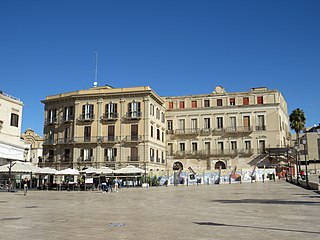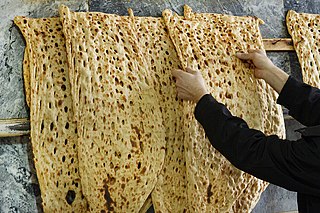
Apulia, also known by its Italian name Puglia, is a region of Italy, located in the southern peninsular section of the country, bordering the Adriatic Sea to the east, the Strait of Otranto and Ionian Sea to the southeast and the Gulf of Taranto to the south. The region comprises 19,345 square kilometers (7,469 sq mi), and its population is about four million people. It is bordered by the other Italian regions of Molise to the north, Campania to the west, and Basilicata to the southwest. The regional capital is Bari.

Bari is the capital city of the Metropolitan City of Bari and of the Apulia region, on the Adriatic Sea, southern Italy. It is the second most important economic centre of mainland Southern Italy after Naples. It is a port and university city, as well as the city of Saint Nicholas. The city itself has a population of 315,284 inhabitants, and an area of over 116 square kilometres (45 sq mi), while the urban area has 750,000 inhabitants. The metropolitan area has 1.3 million inhabitants.

Brindisi is a city in the region of Apulia in southern Italy, the capital of the province of Brindisi, on the coast of the Adriatic Sea. Historically, the city has played an important role in trade and culture, due to its strategic position on the Italian Peninsula and its natural port on the Adriatic Sea. The city remains a major port for trade with Greece and the Middle East. Its industries include agriculture, chemical works, and the generation of electricity.

Focaccia is a flat leavened oven-baked Italian bread. In some contemporary places, such as Rome, it is a style of pizza, also called pizza bianca. Focaccia may be served as a side dish or as sandwich bread and it may be round, rectangular, or square shape.

Capocollo or coppa is a traditional Italian and French (Corsica) pork cold cut (salume) made from the dry-cured muscle running from the neck to the fourth or fifth rib of the pork shoulder or neck. It is a whole-muscle salume, dry cured, and typically sliced very thin. It is similar to the more widely known cured ham or prosciutto, because they are both pork-derived cold cuts used in similar dishes. It is not brined as ham typically is.

Altamura is a town and comune of Apulia, in southern Italy. It is located on one of the hills of the Murge plateau in the Metropolitan City of Bari, 45 kilometres southwest of Bari, close to the border with Basilicata. As of 2017, its population amounts to 70,595 inhabitants.

Sangak or nân-e sangak is a plain, rectangular or triangular Iranian whole wheat leavened flatbread.
Gioia del Colle is a town and comune of the Metropolitan City of Bari, Apulia, southern Italy. The town is located on the Murge plateau at 360 metres (1,180 ft) above sea level, between the Adriatic and Ionian seas.
Santeramo in Colle is a town in the Metropolitan City of Bari and region of Apulia, southern Italy.

Pane di Altamura is a type of Italian naturally leavened bread made from remilled durum wheat semolina from the Altamura area of the province of Bari, in the Apulia region.
The Laterza culture or Laterza-Cellino San Marco culture is an Eneolithic culture in Southern Italy. It takes its name from the tombs discovered in the locality of Laterza, near Taranto, and Cellino San Marco, near Brindisi, in Apulia. It developed in Apulia and Basilicata, and to a lesser extent of Central Italy in the 3rd millennium BC, around 2950-2350 BC. As with many of the cultures of the late prehistoric period, it is known essentially from the style of pottery recovered from archaeological digs. The culture was defined in 1967 by Francesco Biancofiore, following research in a necropolis of the same name situated to the north-west of the city of Taranto, in southern Apulia.

The Metropolitan City of Bari is a metropolitan city in the Apulia region of Italy. Its capital is the city of Bari. It replaced the province of Bari and includes the city of Bari and some forty other comuni. It was first created by the reform of local authorities and then established by the Law 56/2014. It has been operative since January 1, 2015.

Pomodorino di Manduria is an ecotype of tomato typical of Manduria, a city in the province of Taranto. In the local dialect, it is also called "pummitoru paisanu".

The extra-virgin olive oil Terre Tarentine is produced with the olive cultivars Leccino and Coratina and Ogliarola for, at least, 80%. They are mixed with other minor varieties of the local olive groves. It is recognised as PDO product.

Apulian cuisine consists of the cooking traditions and practices of the region of Apulia in Italy. Starting from the Middle Ages the permanent residence of the nobility in the region gradually declined, which caused the disappearance of their noble cuisine over time. As the common people suffered from poverty, their culinary tradition adapted to use cheap and simple foods. Bread, vegetables and pasta have the leading role in the cuisine. Fruits, fish and wine are consumed frequently as well, but meat plays a minor role. The food of Apulia is known as a prime example of cucina povera or 'cuisine of the poor', characterizing its simplicity rather than its quality. Moreover, the simple dishes allow the quality of their local and seasonal ingredients to take center stage.
Angela Bianca Tragni is an Italian journalist and writer. Over her career, she carried out research in the culture of the Italian region Apulia and folklore of Southern Italy. She also wrote books on history, especially the Middle Ages.

The cuisine of Basilicata, or Lucanian cuisine, is the cuisine of the Basilicata region of Italy. It is mainly based on the use of pork and sheep meat, legumes, cereals and vegetables, with the addition of aromas such as hot peppers, powdered raw peppers and horseradish. The local gastronomy is, for historical-cultural reasons, typically peasant, based on simple recipes and on the culture of reuse, in particular of meat and bread.

Bread in Spain has an ancient tradition with various preparations in each region. Wheat is by far the most cultivated cereal, as it withstands the dry climate of the interior of the country. Since time immemorial, bread is a staple food that accompanies all daily meals, all year round. In fact, the Iberian Peninsula is one of the European regions with the greatest diversity of breads. The Spanish gourmet José Carlos Capel estimated a total of 315 varieties of bread in Spain, although the barra is, by far, the most consumed variety of bread (75%). In addition to food, bread in Spain has a historical, cultural, religious and mythological function.

The culture of Apulia, the region that constitutes the extreme southeast of the Italian peninsula, has had, since ancient times, mixed influences from the West and the East, due to its strategic position near the transition zone between these two cultural regions. Its location, on the west coast of the Adriatic and Ionian seas, the natural southern border between Western Europe and the Balkans and Greece, made it a bridge to the East since antiquity, and in the Middle Ages, it was a cultural frontier between the Roman-Germanic West and the Greek-Byzantine East.














